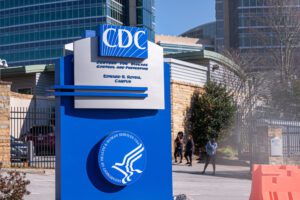With a flick of the wrist, the CDC unveiled its latest magic trick – miraculously ending the pandemic.
Last week the CDC published new, “community level” metrics that focus on three trends: new COVID-19 hospitalizations, hospital capacity, and new COVID-19 cases, which it publicly lists on its website for each county alongside the corresponding COVID-19 risk levels.
According to these new metrics, only about 28 percent of Americans live in a county where they need to wear masks indoors, up from 99 percent of the population merely a few weeks ago. The CDC attributes this stark jump to a change in the metrics measured. Previously the CDC focused on transmission rates. Now they focus on the newly minted community level metrics.

In changing the focus of the data, they changed the recommendations, and effectively ushered in the end of the pandemic. This would appear as welcomed news for those who longed for a merciful end to a pandemic that has long since become endemic. But unlike the rapid turnaround by the CDC, we should not be so quick to judge.
For months, epidemiologists who study viral transmission have called for a change in the metrics measured. Based on studies of other viral pandemics, we know that once a significant portion of the population attains natural immunity, or vaccine-acquired immunity, or both, measuring the risk of a virus through its transmission is no longer an effective measure of its clinical and economic effects on society.
Yet we continued to monitor only transmission rates, seemingly keen on maintaining the most risk adverse stance to the pandemic possible, until being risk adverse proved to be a risk unto itself. Had we utilized other metrics earlier, that the CDC seems to have only recently discovered, we could have adjusted our response to COVID-19 in a more coordinated manner. We would have identified communities on the brink of COVID endemicity months in advance, and lifted economic restrictions in a more step-wise manner, slowly adjusting the restrictions relative to a dynamically decreasing risk.

For most Americans, the pandemic is defined by the masks they are compelled to wear. In removing them, we remove the last vestigial symbols of a pandemic well on its way into the annals of history. And like most things in life, when it leaves our collective conscious, we no longer remain aware of it – out of sight, out of mind.
The CDC fears this may lead the public to let its guard down preliminarily and get caught off guard, should an unforeseen viral mutation reignite the worst of the pandemic. This may be a valid concern. But rather than attempt to explain as much to the public, the CDC simply assumed the public would not understand, and therefore put forth the most risk adverse position as long as possible, until that position was no longer tenable.
By not respecting the intelligence of the public, the CDC in turn lost credibility. This is the nature of reciprocity, how you treat others reflects how they treat you. More fundamentally, this is what happens when we presume that we are following the science when actually we are following an interpretation of it. And when we treat data as an interpretation, the data in turn no longer remain a credible source of information.

The CDC as well as numerous other public and private organizations have been monitoring these community metrics since the beginning of COVID-19. The very phrase, “flatten the curve”, alludes to measuring hospitalization rates relative to hospital capacity constraints. These purportedly novel metrics are nothing new. In fact, they are as old as the pandemic itself.
But by convincing the public it now uses new metrics, the CDC created the appearance that the pandemic has suddenly become less risky than before. In reality, the pandemic has been waning for months.
And like most magic tricks, it is the illusion that captivates the public.















